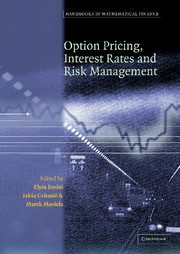Book contents
- Frontmatter
- Contents
- List of Contributors
- Introduction
- Part one Option Pricing: Theory and Practice
- 1 Arbitrage Theory
- 2 Market Models with Frictions: Arbitrage and Pricing Issues
- 3 American Options: Symmetry Properties
- 4 Purely Discontinuous Asset Price Processes
- 5 Latent Variable Models for Stochastic Discount Factors
- 6 Monte Carlo Methods for Security Pricing
- Part two Interest Rate Modeling
- Part three Risk Management and Hedging
- Part four Utility Maximization
3 - American Options: Symmetry Properties
from Part one - Option Pricing: Theory and Practice
Published online by Cambridge University Press: 29 January 2010
- Frontmatter
- Contents
- List of Contributors
- Introduction
- Part one Option Pricing: Theory and Practice
- 1 Arbitrage Theory
- 2 Market Models with Frictions: Arbitrage and Pricing Issues
- 3 American Options: Symmetry Properties
- 4 Purely Discontinuous Asset Price Processes
- 5 Latent Variable Models for Stochastic Discount Factors
- 6 Monte Carlo Methods for Security Pricing
- Part two Interest Rate Modeling
- Part three Risk Management and Hedging
- Part four Utility Maximization
Summary
Introduction
Putcall symmetry (PCS) holds when the price of a put option can be deduced from the price of a call option by relabeling its arguments. For instance, in the context of the standard financial market model with constant coefficients the value of an American put equals the value of an American call with strike price S, maturity date T, in a financial market with interest rate δ and in which the underlying asset price pays dividends at the rate r. This result was originally demonstrated by McDonald and Schroder (1990, 1998) using a binomial approximation of the lognormal model and by Bjerksund and Stensland (1993) in the continuous time model using PDE methods; it is a version of the international putcall equivalence (Grabbe (1983)).
Put-call symmetry is a useful property of options since it reduces the computational burden in implementations of the model. Indeed, a consequence of the property is that the same numerical algorithm can be used to price put and call options and to determine their associated optimal exercise policy. Another benefit is that it reduces the dimensionality of the pricing problem for some payoff functions. Examples include exchange options and quanto options. PCS also provides useful insights about the economic relationship between contracts. Puts and calls, forward prices and discount bonds, exchange options and standard are simple examples of derivatives that are closely connected by symmetry relations.
Some intuition for PCS is based on the properties of the normal distribution. Indeed, in the model with constant coefficients the distribution of the terminal stock price is lognormal.
- Type
- Chapter
- Information
- Handbooks in Mathematical FinanceOption Pricing, Interest Rates and Risk Management, pp. 67 - 104Publisher: Cambridge University PressPrint publication year: 2001
- 25
- Cited by

